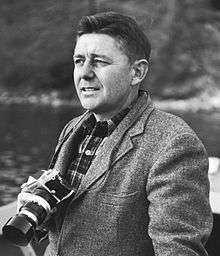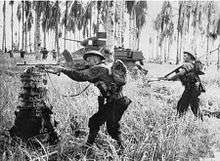George Silk

George Silk (17 November 1916 – 23 October 2004) was a photojournalist. He was born in New Zealand, and served as a photojournalist for Life for 30 years.[1]
Silk's career as a war photographer began in 1939, when he was a combat cameraman for the Australian government, covering action in the Middle East, North Africa and Greece. Trapped with the famed Desert Rats at Tobruk in Libya, he was captured by German Field Marshal Erwin Rommel's forces but escaped 10 days later.
He began working for Life magazine in 1943.
He photographed many events from World War II. He covered the war on the Italian front, the Allied invasions of France and the Pacific. In New Guinea, Silk walked 300 miles with Allied forces, an ordeal later described in the book War in New Guinea. He was with U.S. forces in the Battle of the Bulge in 1944 and was wounded by a grenade during a river crossing in Germany. His co-worker Will Lang Jr. reported on the Battle of the Bulge and the river crossing. He shot the first pictures of Nagasaki, Japan, after the atomic bomb was dropped, as well as Japanese war criminals awaiting trial in postwar Tokyo. He became a U.S. citizen in 1947.
In December 1972, Silk was in Nepal, shooting an assignment on Himalayan game parks, when he received news that the magazine had folded. According to the 1977 book That Was the Life, he replied by saying, "Your message . . . badly garbled. Please send one-half million dollars additional expenses."
He was named magazine photographer of the year four times by the National Press Photographers Association.
References
- Selected photographs by George Silk
 Beach sports under summer skies, Gaza Beach, September 1941
Beach sports under summer skies, Gaza Beach, September 1941 An Australian soldier, Private George "Dick" Whittington, is aided by Papuan orderly Raphael Oimbari, near Buna on 25 December 1942. Whittington died in February 1943 from the effects of bush typhus
An Australian soldier, Private George "Dick" Whittington, is aided by Papuan orderly Raphael Oimbari, near Buna on 25 December 1942. Whittington died in February 1943 from the effects of bush typhus Australian assault on pillbox, January 1943, Papua, Giropa Point
Australian assault on pillbox, January 1943, Papua, Giropa Point_Geroge_Silk_(RESTORED)_(4078245435).jpg) During The Famine Young Child Dying In The Gutter, China (1946)
During The Famine Young Child Dying In The Gutter, China (1946)
| Wikimedia Commons has media related to George Silk. |